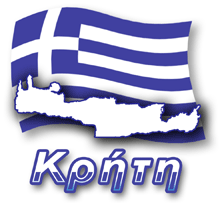
Chania (Χανιά) is the second largest (after Heraklion ) city of Crete. Although the official number of residents does not exceed 58 thousand. however, together with the neighboring towns, Chania forms an agglomeration with a population of approximately 130,000. people. The urban area includes such towns as: Mournies (6,390 people), Nerokouros (4,175 people), Souda (5,330 people), Daratsos (3,277 people), Galatas (2,131 inhabitants), Vamvakopoulo (1,769 people) and Perivolia (3065 people) Such a large number of inhabitants means that the area of the municipality of Chania with 4,248 people per 1 km2 is one of the most densely populated areas of Greece. Higher rates are recorded only in Athens and in the agglomeration of Thessaloniki.
Chania is located on the northern coast of the island, about 70 km west of Rethymno and 145 km west of Heraklion .
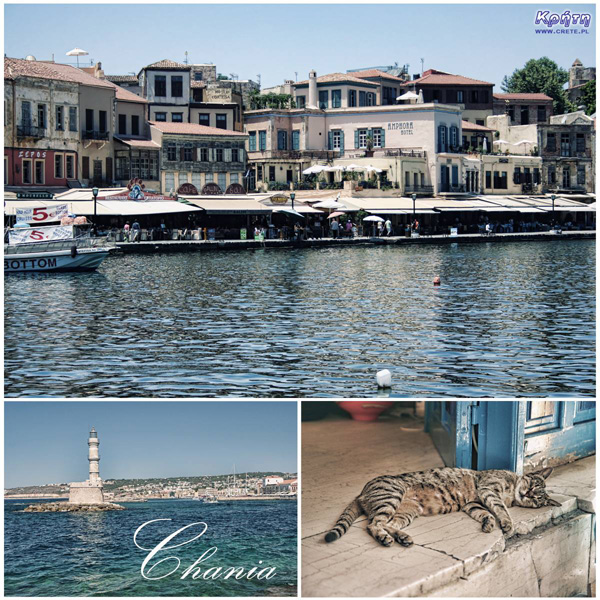
Excavation work carried out on Kasteli towering over the Venetian Port and the Old Town proves that the history of the city of Chania dates back to the Minoan era, and the first inhabitants appeared in these areas in Neolithic times. In 1100 BC the first significant wave of Dorian settlers appears. Kydonia, or simply quince, is the then name of Chani, which is used by the continental Greeks. In those days, the city competes with other cities-states located in this region of Crete. Kydonia is practically in a constant state of war with Aptera, Falasarna and Polyrrinia. Kydoni's importance and importance can be proved by the fact that mentions about him even appeared in Homer's Odyssey. It was not until 69 BC that the Roman consul Caecilius Metellus defeated the Cretans and took control of the city. However, even then Kydonia maintains the status of an independent city-state. Until the third century AD, she managed to keep the right to mint her own coin.
Unfortunately, the history of Kydoni during this period is not well documented. However, it is known that until 961 AD the city is in the hands of Arabs who call them Al Hanim (Inn). In the times of the second Byzantine Empire, the city is again in the hands of Christians, and the Arabic name was changed into Greek: Chania. During this period, in accordance with the Byzantine doctrine, the city is strengthened, which is to prevent future Arab invasions.
For the indigenous inhabitants of Crete, the Venetian occupation was initially quite harsh and burdensome. With time, however, relations between the two nations became more correct. During this period, Chania is chosen as the seat of the Rector (general ruler) of the region. The city obtains the status of an important commercial center. Many of the buildings that can be admired to this day date back to the Venetian period. During this period, Chania is influenced by a mix of three cultures: Venetian, Byzantine and Classical Greek. After the fall of Constantinople, Crete becomes a place of escape for priests and religious, which greatly strengthens the position of the Byzantine religion and culture on this island.
Despite the strong fortification, the city was unable to defend itself against the invasion of Turkish troops that took place in 1645. After two months of siege, the Ottoman army captured Chania, but the capture of the city was occupied by the Turks with very large losses, estimated even at 40,000. people.
From the very beginning of the occupation, the influence of the Ottoman Empire on Chania is very strong. Most churches are turned into mosques, and many clerics are "converted" to Islam. The face of the city in which new mosques appear, public baths (Hammam) and fountains are also being changed. It was in these times that the mosque "Kioutsouk Hassan Tzamissia" was built.
Until the end of the Ottoman occupation, the relations between the Cretans and the Turks were tense. The uprising that broke out in 1821 was an expression of the growing reluctance of the indigenous inhabitants of Crete to occupy.
In 1898, strong movements for independence from the influence of the Ottoman Empire led to the creation of a semi-autonomous Cretan country under the patronage of Great Britain, France, Italy and Russia. In those years, Chania was the capital of Crete and an important centerpower. The city gained the status of a cosmopolitan center where the influence of European and Eastern civilization was intersecting.
December 1, 1913 is an important date in the history of Crete, because it was on this day in the old fortress located at the Venetian port for the first time officially raised the Greek flag. All this was the finale of the several-year strong policy of Eleftherios Venizelos, who from 1905 sought to unite Crete with continental Greece.
As a result of the German invasion of Crete, part of Chania was bombed. The opposition of the civilian population to the occupant and the intensified activity of the resistance led to strong repressions against the people living in the vicinity of Chania. A large part of the inhabitants of the neighboring villages and towns were imprisoned.
The period of World War II also left a strong mark on the Jewish community living in Chania. Their tragic fate was sealed by a British submarine, which in 1944 torpedoed the "Tanais" ship carrying Jewish prisoners to mainland Greece.
Luckily, Crete and Kania missed the disastrous consequences of the Greek civil war that broke out in the mainland after the Second World War. The period of the 1950s was a time of rebuilding the damage that the German occupation left behind. Since 1970, Crete has become one of the most important tourist centers, which leads to a significant acceleration of the city's development. In 1971, Chania was lost to the capital of Crete for Heraklion.

Chania and Rethymnon are two cities that have been fighting for the name of the most beautiful city in Crete. Unfortunately, but there is no unambiguous answer to the question about which cities should win in this competition, so everyone has to form their own opinion.
The biggest advantage of Chania is the Old Town and the beautiful Venetian Harbor. Accurate building of old tenement houses divided by small streets creates an amazing atmosphere of this city. Anyway, calling these small streets is a huge exaggeration, because in many places the neighboring buildings are separated by a distance that is not much higher than the span of an adult male. However, this narrowness does not prevent the narrow streets from finding a place for even a few tables served by the waiters of a nearby cafeteria or a tavern. The labyrinth of intersecting crossings within the Old Town is also a great place to buy typical tourist souvenirs and local products.
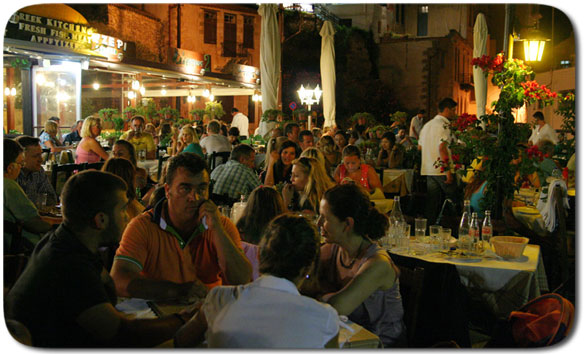
Evening view of the taverns along the Venetian Harbor
If there is such a possibility, it is also worth visiting this part of the city in the late evening or at night. Beautifully lit tenement houses whose reflections glisten in the harbor bay - create an amazing atmosphere. The taverns are usually empty during the day, in which the only people who sit at the tables are service, they change their face at night completely. Waiters, fighting at midday for single customers passing through the Venetian Port, in the evenings have their hands full. This is not surprising, because finding a free table at this time is a really difficult task.
Chania is located in the northwest of Crete, with a small isthmus between the Akrotiri peninsula and the rest of the island. Access by car to Chania, as in the case of other major towns of Crete, is relatively easy and should not cause any problems. It's best to take advantage of the New National Road, which being the southern beltway of Chania allows you to easily reach the outskirts of this city. It is worth paying attention to leaving the road using the right exit. Driving from the eastern side of Crete, it is better to avoid the first exits, as crossing them forces you to cross the port town of Souda and the vast suburbs of Chania.

Direct access to the city center is also easily accessible by public transport. The bus runs every hour on the route between Heraklion and Chania in about 3 hours. Unfortunately, it is notb with relatively high travel costs, as a one-way ticket is an expense of around € 14. In the case of two or more people traveling, it may be cheaper to rent a small car.
The most important places to see are:
↤ click the appropriate part of the island to change the bottom map
W 2002 roku Falasarna zdobyła tytuł najlepszej plaży w Grecji. Wyróżnienie to nie jest bynajmniej przypadkowe, gdyż miejsce to jak na standardy Krety jest naprawdę unikalne.
Elafonisi is a small island located at the end of the southwestern edge of Crete. A characteristic feature of Elafonisi is the shallow lagoon connecting it with Crete.
Elafonisi is a small island located at the end of the southwestern edge of Crete. A characteristic feature of Elafonisi is the shallow lagoon connecting it with Crete.
This is the second largest airport (IATA code: CHQ) in Crete. In 2010, the airport in Chania served a total of over 1.65 million passengers.
Chania (Χανιά) is the second largest (after Heraklion) city of Crete. The biggest advantage of Chania is the area of the Old Town and the beautiful Venetian Harbor.
Aptera is a city whose history dates back to at least a thousand years before our era. In the peak period, about 20,000 lived in it. people, of which only 1/5 were free people.
Chania (Χανιά) is the second largest (after Heraklion) city of Crete. The biggest advantage of Chania is the area of the Old Town and the beautiful Venetian Harbor.
The genesis of the name of this poviat will not surprise anybody who will break the road from the Imbros gorge to Hora Sfakion.
Frangokastello is a small fortress that was built by the Venetians over four years from 1371. Initially, the castle was named after Saint Nikitas.
(Χρυσοσκαλίτισσα) The Church of the Blessed Virgin Mary with the Golden Step from the 17th century is the westernmost church building of this type.
(Χρυσοσκαλίτισσα) The Church of the Blessed Virgin Mary with the Golden Step from the 17th century is the westernmost church building of this type.
Omalos is a perfect starting point for exploring the Samaria Gorge. Located over 1,100 m above sea level extends over an area of 25 km2. Its size corresponds more or less to the size of the Lasithi Plateau.
Located 47 km from the city of Chania, it is the only freshwater lake in Crete. Its area is about 580 thousand. sqm. and the maximum depth is about 45 meters
Omalos is a perfect starting point for exploring the Samaria Gorge. Located over 1,100 m above sea level extends over an area of 25 km2. Its size corresponds more or less to the size of the Lasithi Plateau.
The steel crossing, which in the central part is separated from the ground by nearly 150 m, is at the leading position of the places where the longest bungee jumps are made.
Chania (Χανιά) is the second largest (after Heraklion) city of Crete. The biggest advantage of Chania is the area of the Old Town and the beautiful Venetian Harbor.
The genesis of the name of this poviat will not surprise anybody who will break the road from the Imbros gorge to Hora Sfakion. Word
This is the second largest airport (IATA code: CHQ) in Crete. In 2010, the airport in Chania served a total of over 1.65 million passengers.
Chora Sfakion is an extremely picturesque mountain village of the mountainous and wild Sfakia region
Loutro is famous for the fact that you can get to it only from the sea or walk on the mountain trail, because there is no other road here.
Stavros used to be a small fishing village. Today, it is primarily a tourist destination, but in a positive sense.
The cave is less than 1 km from Moni Gouvernetou Monastery. You will reach it using the pedestrian trail that has been marked out along the slope of the Avlaki Gorge.
Balos is one of Crete's flagship beaches if not all of Greece. We can assure you that the landscapes you see during your trip to Balos will remain with you for a very long time.
Moni Katholiko is probably the oldest and most spectacular monastery in Crete. It is located 20 km north-east of Chania.
The Orthodox monastery of Agia Triada, located on the northern part of the Akrotiri peninsula, is one of the most beautiful and richest monasteries in Crete.
The Orthodox monastery of Agia Triada, located on the northern part of the Akrotiri peninsula, is one of the most beautiful and richest monasteries in Crete.
Gouverneto Monastery is probably the oldest active Greek Catholic monastery located on the Akrotiri peninsula near Chania.
The length of the trail leading through this place is about 8 kilometers and the difference in altitude is about 600m.
Agia Roumeli znajduje się na południowym wybrzeżu Prefektury Chania, pomiędzy miejscowościami Chora Sfakion i Paleochora.
Until the early nineties, this place was known only to few tourists and local residents.
Paleochora is a quite well-organized tourist town, with a beautiful large sandy beach
Ruiny starożytnego miasta Lissos znajdują się około 3,5 km od miejscowości Sougia na południowym wybrzeżu Krety.
Samaria is one of the most important tourist attractions located in the western part of Crete.
On the north-western coast of Crete, at the foot of the Gramovous peninsula, there are ruins of the ancient port of Korikos, later known as Falassarna.
Krios Beach is located about 9 km west of Paleochora and it is also the last beach on this stretch of the southern coast
Between the villages of Topolia and Koutsamatados there is an interesting cave known as Agia Sofia
Milia is an authentic mountain settlement, which most probably dates from about the seventeenth century.
On the edge of the village of Potamida grows a complex of clay mounds called Komolithi (Komolithoi)
Grammeno (Γραμμένο) is a beach that can be counted among one of the best and most beautiful beaches in this part of Crete.
Platanias is a popular tourist destination. It is here that there are very interesting tunnels from World War II.
Polyrinia was one of the most important city-states of western Crete during the Hellenistic and Roman periods. It was built amphitheater on a steep hill, rising to a height of 481 meters above sea level
The Agia Irini gorge, just a short distance from the village of Sougia, is one of the most popular hiking destinations.
The island of Gramvousa, or in fact Imeri Gramvousa (Ήμερη Γραμβούσα), is an inseparable point of a trip that combines a stay in the Balos Lagoon with visiting the remains of a fortress located on the top of the island of Imeri Gramovousa.
Agia Roumeli is located on the south coast of Chania Prefecture, between Chora Sfakion and Paleochora.
The Byzantine church of Agios Pavlos was erected on the remote Selouda Beach in the south of Crete.
There is a beach in Crete that literally makes some people shiver. This place is Seitan Limania which can be translated as Satan's Ports or Cursed Ports.
Aspri Limni means White Lake, although the lake is just a conventional name. Under this term there is a small bay.
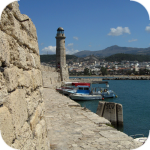
Rethymnon with less than 40,000 inhabitants, it is the third and largest city of Crete after Heraklion and Chania. The city lies in the north-western part of Crete, more or less in the middle of the New National Road section connecting Chania and Heraklion. Despite the fact that this place was already populated in the Minoan period, almost no traces from that period have survived to this day.
Redirected from the side - Olous - ancient Elounda. Although Elounda seems to be a sleepy fishing town to this day, however, appearances should not fool you, because this town and its surroundings can boast of probably the largest number of hotels with the highest standards of service. Beautiful landscape and an amazing view of the Mirambello bay is the reason why Elounda was so quickly and greedily absorbed by modern mass tourism. In luxurious SPA resorts, the most famous guests from Greece and around the world spend their holidays. It was in this place that Lady Gaga rested,
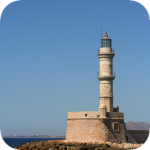
Redirected from the site - Hania. Chania (Χανιά) is the second largest (after Heraklion) city of Crete. Although the official number of residents does not exceed 58 thousand. however, together with the neighboring towns, Chania forms an agglomeration with a population of approximately 130,000. people. Chania is located on the northern coast of the island, about 70 km west of Rethymno and 145 km west of Heraklion.
Komentarze
Najpiękniejsze miasto na Krecie?
A Wam które z kreteńskich miast najbardziej przypadło do gustu, bo mi osobiście jednak najbardziej podobał się Rethymnon :).
Najpięniejsze miasto na Krecie
No cóż, podobno o gustach się nie dyskutuje! Mnie się podobała najbardziej stara część Chanii, byłam dwa razy i ciągle mi mało!!! Do Rethymnonu nie dotarłam, może w tym roku :D
Wolę Rethymnon .
W Chani robi wrażenie kolorowe nabrzeże,ale rażą sypiące się domy,o ktore nikt wczesniej nie zadbał.Zdecydowanie wolę Rethymnon. Myślę,ze Kreta jest przereklamowana,piękniej było w Gruzji,bardziej zielono. (maj 2014 r. )
r
Chania
Byłam w obu ale serce zostawiłam w Chanii
Najlepszy sok pomarańczowy
Witam Wszystkich,
Podczas naszego ostatniego pobytu na Krecie odwiedziliśmy kolejny raz Chanię. Wędrując bez celu po uliczkach starego miasta trafiliśmy przypadkiem na cudowne miejsce a mianowicie malutką kafejkę prowadzoną przez leciwego już Greka. Polecamy każdemu wizytę w tym miejscu, można tam skosztować przepysznego soku z pomarańczy, greckiej kawy, prawdopodobnie domowego wina i czegoś co wyglądało jak mleko z cynamonem (jakiś pan obok nas to pił). Poza nami w kawiarence byli tylko Grecy - średnia wieku wskazywała, że mogą pamiętać bitwę pod Troją :-)
AOENEIO KOYNOYPAKHE
Unnamed Road, Chania 731 32
G289+2W ChaniaBardzo łatwo tam trafić, wychodząc z Agory skręcamy w lewo i po 15 - 20 metrach kierujemy się w prawo w wąską uliczkę bez nazwy.
Wypełnij poniższy formularz aby dodać komentarz